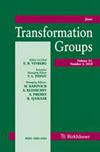哪些舒伯特品种是海森伯格品种?
IF 0.4
3区 数学
Q4 MATHEMATICS
引用次数: 3
摘要
在证明复约群G的满旗变种中的每一个Schubert变种都是一般的Hessenberg变种之后,我们证明了并非所有这样的Schubert变种都是伴随Hessenberg变种。事实上,在A和C类型中,我们提供了模式回避准则,暗示随着G的增加,Schubert品种是伴随的Hessenberg品种的比例趋于零。我们还证明了在A型中,一些Schubert变种与任何伴随的Hessenberg变种不同构。本文章由计算机程序翻译,如有差异,请以英文原文为准。
Which Schubert Varieties are Hessenberg Varieties?
After proving that every Schubert variety in the full flag variety of a complex reductive group G is a general Hessenberg variety, we show that not all such Schubert varieties are adjoint Hessenberg varieties. In fact, in types A and C, we provide pattern avoidance criteria implying that the proportion of Schubert varieties that are adjoint Hessenberg varieties approaches zero as the rank of G increases. We show also that in type A, some Schubert varieties are not isomorphic to any adjoint Hessenberg variety.
求助全文
通过发布文献求助,成功后即可免费获取论文全文。
去求助
来源期刊

Transformation Groups
数学-数学
CiteScore
1.60
自引率
0.00%
发文量
100
审稿时长
9 months
期刊介绍:
Transformation Groups will only accept research articles containing new results, complete Proofs, and an abstract. Topics include: Lie groups and Lie algebras; Lie transformation groups and holomorphic transformation groups; Algebraic groups; Invariant theory; Geometry and topology of homogeneous spaces; Discrete subgroups of Lie groups; Quantum groups and enveloping algebras; Group aspects of conformal field theory; Kac-Moody groups and algebras; Lie supergroups and superalgebras.
 求助内容:
求助内容: 应助结果提醒方式:
应助结果提醒方式:


